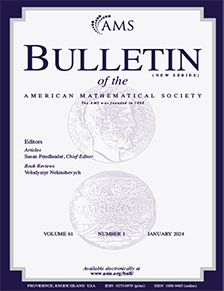Missed opportunities
HTML articles powered by AMS MathViewer
- by Freeman J. Dyson PDF
- Bull. Amer. Math. Soc. 78 (1972), 635-652
References
-
1. D. Hilbert, Mathematische Probleme, Lecture to the Second Internat. Congress of Math. (Paris, 1900), Arch. Math. und Phys. (3) 1 (1901), 44-63; 213-237; English transl., Bull. Amer. Math. Soc. 8 (1902), 437-479.
2. H. Minkowski, Raum und Zeit, Lecture to the 80th Assembly of Natural Scientists (Köln, 1908), Phys. Z. 10 (1909), 104-111. English transl., The principle of Relativity, Aberdeen Univ. Press, Aberdeen, 1923.
- I. G. Macdonald, Affine root systems and Dedekind’s $\eta$-function, Invent. Math. 15 (1972), 91–143. MR 357528, DOI 10.1007/BF01418931
- G. H. Hardy, Ramanujan. Twelve lectures on subjects suggested by his life and work, Cambridge University Press, Cambridge, England; The Macmillan Company, New York, 1940. MR 0004860 5. S. Ramanujan, On certain arithmetical functions, Trans. Cambridge Philos. Soc. 22 (1916), 159-184. 6. L. J. Mordell, On Mr. Ramanujan’s empirical expansions of modular functions, Proc. Cambridge Philos. Soc. 19 (1917), 117-124.
- E. Hecke, Über Modulfunktionen und die Dirichletschen Reihen mit Eulerscher Produktentwicklung. II, Math. Ann. 114 (1937), no. 1, 316–351 (German). MR 1513142, DOI 10.1007/BF01594180
- Morris Newman, An identity for the coefficients of certain modular forms, J. London Math. Soc. 30 (1955), 488–493. MR 70658, DOI 10.1112/jlms/s1-30.4.488
- R. C. Gunning, Lectures on modular forms, Annals of Mathematics Studies, No. 48, Princeton University Press, Princeton, N.J., 1962. Notes by Armand Brumer. MR 0132828, DOI 10.1515/9781400881666
- Lasse Winquist, An elementary proof of $p(11m+6)\equiv 0\,(\textrm {mod}\ 11)$, J. Combinatorial Theory 6 (1969), 56–59. MR 236136, DOI 10.1016/S0021-9800(69)80105-5 11. C.G.J. Jacobi, Fundamenta nova theoriae functionum ellipticarum, Königsberg, 1829, 66, Eq. (5). 12. F. Klein and R. Fricke, Vorlesungen über die Theorie der elliptischen Modulfunktionen. Vol. 2, Teubner, Leipzig, 1892, p. 373. 15. J. Clerk Maxwell, A dynamical theory of the electromagnetic field, Philos. Trans. Roy. Soc. (London) 155 (1865), 459-512. 16. J. Clerk Maxwell, Presidential Address to Section A (Mathematical and Physical Sciences) of the British Association, Liverpool, 1870. Nature 2 (1870), 419-422.
- Isaac Newton, Mathematical principles of natural philosophy. Vol. 1: The motion of bodies, University of California Press, Berkeley-Los Angeles, Calif., 1962. Translated into English by Andrew Motte in 1729; The translations revised, and supplied with an historical and explanatory appendix, by Florian Cajori. MR 0175747 18. Henry J.S. Smith, Presidential Address to Section A (Mathematical and Physical Sciences) of the British Association, Bradford, 1873. Nature 8 (1873), 448-452. 19. J. Clerk Maxwell, A treatise on electricity and magnetism, Oxford Univ. Press, Oxford, 1873. 20. Michael Pupin,From immigrant to inventor, 1924. 21. H. Bacry and J.-M. Lévy-Leblond, Possible kinematics, J. Mathematical Phys. 9 (1968), 1605-1614. MR 38 # 6821. To save time I have slightly misstated their conclusion; each of the groups D, P′ and N can occur in two alternative forms, so that the number of possibilities is strictly speaking 11 rather than 8.
- Jean-Marc Lévy-Leblond, Une nouvelle limite non-relativiste du groupe de Poincaré, Ann. Inst. H. Poincaré Sect. A (N.S.) 3 (1965), 1–12 (French, with English summary). MR 192900 23. L. Carroll, Through the looking-glass, and what Alice found there, Macmillan, London, 1871. 24. J. Willard Gibbs, On multiple algebra, Vice-Presidential Address to the Section of Mathematics and Astronomy of the American Association for the Advancement of Science, Proc. Amer. Assoc. Adv. Sci. 35 (1886), 37-66. 25. W. R. Hamilton, On quaternions; or on a new system of imaginaries in algebra, Philos. Mag. 25 (1844), 10-13. 26. H. Grassmann, Die lineale Ausdehnungslehre, ein neuer Zweig der Mathematik, Otto Wigand, Leipzig, 1844.
- Richard Brauer and Hermann Weyl, Spinors in $n$ Dimensions, Amer. J. Math. 57 (1935), no. 2, 425–449. MR 1507084, DOI 10.2307/2371218 28. A. Einstein, Die Grundlage der allgemeinen Relativitätstheorie, Ann. Phys. 49 (1916), 769-822.
- Rudolf Haag and Daniel Kastler, An algebraic approach to quantum field theory, J. Mathematical Phys. 5 (1964), 848–861. MR 165864, DOI 10.1063/1.1704187
- Jacques Dixmier, Les $C^{\ast }$-algèbres et leurs représentations, Cahiers Scientifiques, Fasc. XXIX, Gauthier-Villars & Cie, Éditeur-Imprimeur, Paris, 1964 (French). MR 0171173
- R. P. Feynman, Mathematical formulation of the quantum theory of electromagnetic interaction, Phys. Rev. (2) 80 (1950), 440–457. MR 41726, DOI 10.1103/PhysRev.80.440
- R. E. Peierls, The commutation laws of relativistic field theory, Proc. Roy. Soc. London Ser. A 214 (1952), 143–157. MR 51725, DOI 10.1098/rspa.1952.0158
- I. M. Gel′fand and A. M. Jaglom, Integration in functional spaces and its applications in quantum physics, J. Mathematical Phys. 1 (1960), 48–69. MR 112604, DOI 10.1063/1.1703636 34. J. von Neumann, Über ein ökonomisches Gleichungssystem und eine Veralgemeinerung des Brouwerschen Fixpunktsatzes, Ergebnisse eines mathematischen Seminars, edited by K. Menger, Wien, 1938; English transl., Rev. Economic Studies 13 (1945), 1-9. 35. E. W. Brown, Resonance in the solar system, Bull. Amer. Math. Soc. 34 (1928), 265-289.
- C. J. Cohen and E. C. Hubbard, A nonsingular set of orbit elements, Astronom. J. 67 (1962), 10–15. MR 135582, DOI 10.1086/108597
- Jacques Hadamard, The Psychology of Invention in the Mathematical Field, Princeton University Press, Princeton, N. J., 1945. MR 0011665, DOI 10.2307/2296111
Additional Information
- Journal: Bull. Amer. Math. Soc. 78 (1972), 635-652
- DOI: https://doi.org/10.1090/S0002-9904-1972-12971-9
- MathSciNet review: 0522147


